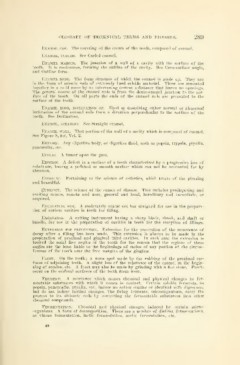Page 547 - My FlipBook
P. 547
GLOSSARV OF TECHNICAL TERMS AND PHRASES. 289
Enamel cap. The covering of the crown of the tooth, composed of enamel.
Enamel, cukled. See Curled enamel.
Enamel margin. The junction of a wall of a cavity with the surface of the
tooth. It is continuous, forming the outline of the cavity. See Cavo-surface angle,
and Outline form.
Enamel rods. Tlic form elements of which the enamel is made up. They are
in the form of minute rods of extremely hard calcific material. These are cemented
together in a solid mass by an intervening cement sub.stance that leaves no openings.
The general course of the enamel rods is from the dento-cnamel junction to the sur-
face of the tooth. On all parts the ends of the enamel rods are presented to the
surface of the tooth.
E.NAMEL RODS, INCLINATION OF. Used in describing either normal or abnormal
inclination of the enamel rods from a direction perpendicular to the surface of the
tooth. See Inclination.
Enamel, straight. See Straight enamel.
Enamel vtall. That portion of the wall of a cavity which is composed of enamel.
See Figure 8, ew. Vol. 2.
Enzyme. Any digestive body, or digestive fluid, such as pepsin, trypsin, ptyalin,
pancreatin, etc.
Epulis. A tumor upon the gum.
Erosion. A defect in a surface of a tooth characterized by a progressive loss of
substance, leaving a polished or smooth surface which can not be accounted for by
abrasion.
Esthetic. Pertaining to the science of esthetics, which treats of the pleasing
and beautiful.
Etiology. The science of the causes of disease. This includes predisposing and
exciting causes, remote and' near, general and local, hereditary and immediate, or
acquired.
Excavating bur. A moderately coarse cut bur designed for use in the prepara-
tion of carious cavities in teeth for filling.
Excavator. A cutting instrument having a sharp blade, shank, and shaft or
handle, for use in the preparation of cavities in teeth for the reception of fillings.
Extension for prevention. Extension for the prevention of the recurrence of
decay after a filling has been made. This extension is always to be made in the
preparation of proximal and gingival third cavities. In each case the extension is
toward the axial line angles of the tooth for the reason that the regions of these
angles are the least liable to the beginnings of caries of any portion of the circum-
ference of the tooth near the free margins of the gingivsB.
Facet. On the teeth; a worn spot made by the rubbing of the proximal sur-
faces of adjoining teeth. A slight loss of the substance of the enamel in the begin-
ning of erosion, etc. A facet may also be made by grinding with a fine stone. Facets
occur on the occlusal surfaces of the teeth from wear.
Ferment. A substance which causes chemical and physical changes in fer-
mentable substances with which it comes in contact. Certain soluble ferments, as
pepsin, pancreatin, ptyalin, etc., induce an action similar or identical with digestion;
but do not induce further changes. The living ferments, microorganisms, carry the
process to its ultimate ends by converting the fermentable substances into other
chemical compounds.
Fermentation. Chemical and physical changes induced by certain micro-
organisms. A form of decomposition. There are a number of distinct fermentations,
as vinous fermentation, lactic fermentation, acetic fermentation, etc.
29


